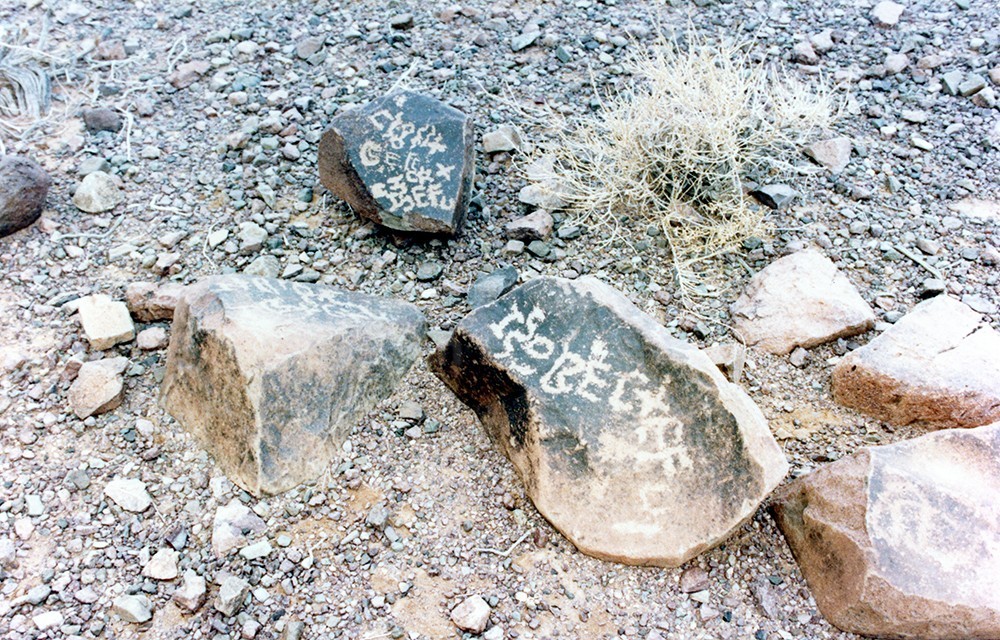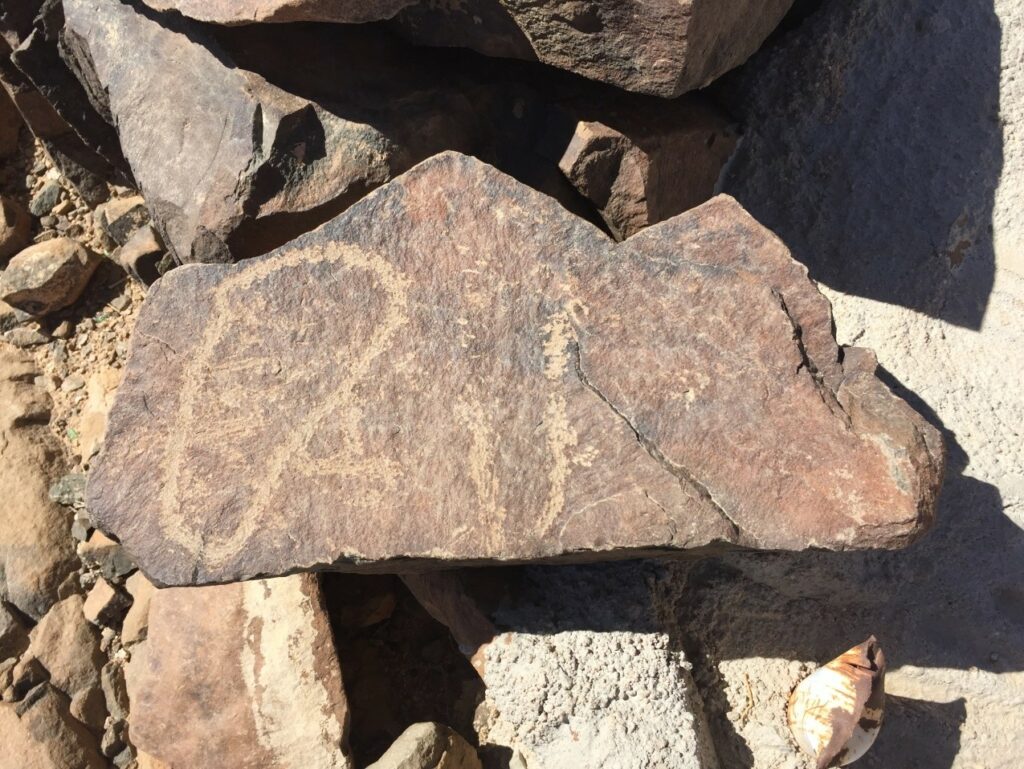Proto-Hebrew Inscriptions In Mount Sinai Area

The Saudis have confirmed that there are hundreds of Thamudic inscriptions in the area around the Jabal Maqla mountain. The archaeologists commissioned by the Saudi government reject the notion that the inscriptions qualify as evidence of the Israelites having been there. However, at least two experts in ancient Hebrew inscriptions are confident that these proto-Hebrew inscriptions at Mount Sinai substantiate the Exodus account.
Dr. Miles Jones, a scholar of ancient Hebrew and a historical linguist, has examined photographs of Thamudic inscriptions from the area. He concluded that they are proto-Hebrew and date back to the time of the Exodus, proving the presence of Hebrew speakers at that time.
His analysis is supported by the independent work of Todd Eaton, another expert on proto-Hebrew inscriptions, who traveled to Jabal Maqla in the mid-1990s. He says he saw inscriptions with Hebrew lettering and depictions of sandals, menorahs, and shofars in the plain in front of Jabal Maqla.
These two experts independently concluded that inscriptions near the Split Rock northwest of Jabal Maqla and near the mountain refer to Yahweh, the Hebrew name for God.
Sandal/Foot Inscriptions
Jim and Penny Caldwell, who used to work in Saudi Arabia and visited Jabal Maqla many times, reported finding countless inscriptions showing feet in sandals near the mountain and near the possible Split Rock of Rephidim site.
It is written in Deuteronomy 11:24 and Joshua 1:3 that God told the Israelites, “Every place where you set your foot will be yours.” The Caldwells and the two aforementioned experts in proto-Hebrew drew a connection between these verses and the footprint inscriptions that appeared to be marking Hebrew territory.
Below is a picture that was taken by the Doubting Thomas Research Foundation of one of the many footprint inscriptions near the possible Split Rock site in 2018:

When Dr. Miles Jones observed the pictures originally taken by the Caldwells, he was stunned when he noticed three hash marks drawn next to the sandals in the inscriptions. He immediately recognized it as the proto-Hebrew origin of the Hebrew letter, kaph.
The letter literally means “sole of the foot,” according to Dr. Jones. Footprint-tracing is a widely recognized sign of ownership. He believes this became the Israelites’ wasum, or tribal sign.
Todd Eaton independently reached the same conclusion in the mid-1990s, long before before he was even aware of the Caldwells' findings or the work of Dr. Miles Jones. He first began communicating with researchers about this topic in 2018.
The Oldest Menorah Ever Found?
Dr. Sung Hak Kim, a South Korean doctor who was once the personal physician to the Governor of Mecca, was granted wide-ranging permission to explore northwest Saudi Arabia because of his high-level friendships.
During his searches, he discovered what is likely the oldest-known depiction of a menorah in one of the valleys that leads to Jabal Maqla. The image appears on a large rock with various other inscriptions. He has provided us the photographs below:


The menorah is a very important symbol in Judaism, dating all the way back to the time described in Exodus 25:31-32 where the menorah is mentioned as an integral part of the tabernacle. The inscription of a menorah in this location is highly indicative of an ancient Hebrew presence.
Proto-Hebrew Inscriptions At Mount Sinai Possibly Referring to the Amalekites
The sandal inscriptions found near the Split Rock are adjacent to a flat plain that may have been the battlefield where Joshua led an Israelite army to fight the Amalekites after they attacked the Israelite population from the rear, preying upon the most vulnerable who straggled behind.
The Caldwells claim that they have found slingstones in the possible battlefield area. The location is consistent with what is currently understood about where the Amalekites resided, though little is known about the Amalekites overall.
The Encyclopedia Brittanica states “The district over which they [the Amalekites] ranged was south of Judah and probably extended into northern Arabia.”[1] The Jewish Encyclopedia likewise states that the Amalekites were in northern Arabia at this time.[2] Additionally, Dr. Lennart Möller writes in The Exodus Case that the Amalekites were an Arabian people, the oldest tribe of Arabia and the founders of the city of Medina.[3]
Two inscriptions have been found to the south of Jabal Maqla that may refer to the battle with the Amalekites. However, this location poses some difficulties. It is a significant distance from the Split Rock location that is to the northwest of Jabal Maqla and indicates that the Israelites approached the mountain from the north.
The below inscription found by the Caldwells was interpreted by Dr. Miles Jones to say, “Died Amalek.” The inscription shows where an Amalek (a member of the Amalekite tribe) died. It does not necessarily mean he was buried there. Todd Eaton interpreted it differently. He believes it is identifying the spot where a high priest died.

This inscription is near another two inscriptions that are said to mark where an Israelite mother and daughter died. The inscription on the top rock in the image below is interpreted by Dr. Jones to mean, “Died Hagar.” The lower inscription says, “Died Amiah, daughter of Hagar.”

If Dr. Jones is correct, then their placement near each other appears to record an event that is consistent with the Biblical account. A mother and her young daughter would be among the vulnerable "stragglers" towards were attacked by the Amalekites from the tear. Murdering a mother and daughter would certainly fit the Biblical description of a despicable sneak attack upon the weak by the Amalekites. If the nearby inscription states "Died Amalek," then this could very well be where one of the Amalekite murderers of that Hebrew mother and daughter was killed.
Again, these three inscriptions were found to the south of Jabal Maqla and were not among the inscriptions at the Split Rock, where the battle with the Amalekites is likely to have taken place if the Split Rock is the "Rock of Horeb." Therefore, if the inscriptions refer to the battle with the Amalekites, then they are retelling the story. Dr. Miles Jones believes that the Amalekites attacked the Israelites multiple times, including during their stay at Jabal Maqla.
Inscription Possibly Identifying Rephidim
The following inscription, photographed by the Doubting Thomas Research Foundation near the Split Rock, appears to confirm that this site was an encampment for Hebrew speakers. The book of Exodus names the Israelites’ encampment (and the location where they fought the Amalekites) as "Rephidim." Most sources say that Rephidim means “place of rest.” Other sources say it means “supports,” referring to how it strengthened or rejuvenated the Israelites.[4]
Dr. Miles Jones and Todd Eaton separately identified the below inscription as proto-Hebrew. They both interpreted it to mean, “place of rest,” or “to stretch out,” as one stretches out their legs to relax. Therefore, it can be argued that this inscription is synonymous with the name “Rephidim.”

There are several other inscriptions in this area as well. For example, below is a picture of an inscription that Todd Eaton believes references Yahweh:

Eaton told us that this inscription is expressing gratitude to Yahweh for providing a ram. This may be a reference to the ritual animal sacrifices practiced by the Israelites at this time.
Literacy Covenant Theory
Dr. Miles Jones and Todd Eaton have independently come to the conclusion that the proto-Hebrew inscriptions in the area indicate that the alphabet, and therefore literacy, originated from this area of Saudi Arabia and is part of the Exodus story.
Many are unaware of the fact there has actually only ever been one alphabet of letters symbols. The original alphabet was spread to different people groups over the course of history where it was altered and adapted to fit the particular language of each group.
Powerful archaeological and inscriptional evidence has pointed to the Israelites as being the originators of this alphabet, which will be discussed further in future articles.
In his book, The Writing of God, Dr. Miles Jones argues that God made a "literacy covenant" at Mount Sinai with the Israelites. God's forbidding of graven images on rock forced the Israelites to read, write and evolve from hieroglyphic communication to an alphabet.
Graven images on rock were forbidden in order to force the Israelites to read, write, and evolve from hieroglyphic communication to an alphabet, beginning modern literacy using letters instead of Egyptian hieroglyphics.
Dr. Jones writes:
“The alphabet was the most important innovation in human history. Its advent marks the great divide between pagan worship and monotheism, between superstitious thinking and analytical thinking. The result of alphabetic writing and literacy has been the dramatic acceleration of human achievement in all areas of knowledge.”
Todd Eaton independently reached a similar conclusion after viewing the inscriptions first-hand. He also theorizes that the Hebrew alphabet was taught using the stars in the Ecliptic plane.
He says he noticed that the alphabets "appear" in the stars (the constellations) when he slept outside at Jabal Maqla with a consistent orientation. The letters become visible in the sky from right to left, which is how Hebrew is read.
He believes the ancient Hebrews developed the alphabet using different constellations as a basis for the characters.
The proto-Hebrew inscriptions at Mount Sinai offer a fascinating piece of evidence for the theory that Jabal Maqla is the correct location for the Exodus account.
Bibliography
[1] “Amalekite.” Encyclopedia Brittanica. https://www.britannica.com/topic/Amalekites
[2] W. Max Muller, Kaufmann Kohler. Amalek, Amalekites. Jewish Encyclopedia. http://www.jewishencyclopedia.com/articles/1351-amalek-amalekites
[3] Lennart Möller, The Exodus Case, 4th ed. (Copenhagen, Denmark: Scandinavia Pub. House, 2010), 278.
[4] “Rephidim.” Bible Study Tools. https://www.biblestudytools.com/dictionary/rephidim/
Last updated July 22, 2019.

Thanks for sending this site.God bless you and doing good for Christan people to remember Moses done
Thanks for seeing that moses has done.
This is the most extensive website I have come about after a long search on the internet on the subject.
Congretualtions with excavating this ton of evidence on the Exodus.
How much more evidence does a man need te be convinced?
I will refer to your site from mine (dutch, with all kinds of subjects on our faith in the God of Abraham, Isaac and Jacob, Jesus.
Greetings,
Peter